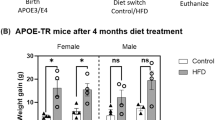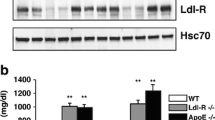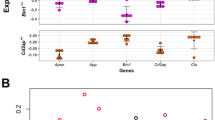Abstract
The emergence of conflicting reports on the natural occurrence of Alzheimer’s disease (AD) in non-human primates has prompted research on the comparison of the role of diet-associated changes in gene expression between humans and non-human primates. This article analyzes the effects of different human and chimpanzee diets and their link with apolipoproteins, lipid, and iron (Fe) metabolism, starting from available data, to find out any gap in the existing knowledge. By using a system biology approach, we have re-analyzed the liver and brain RNA seq data of mice fed with either human or chimpanzee diet for 2 weeks to look for genetic differences that may explain the differences in AD occurrence between those two classes. In liver samples of mice fed with the chimpanzee diet in comparison to the human diet, apolipoprotein A-1, ceruloplasmin, and 10 other genes were upregulated while 21 genes were downregulated. However, brain apolipoprotein E4 gene expression was not changed upon diet. Genetic, structural, and functional differences in apolipoprotein E protein, along with differences in Fe metabolisms and a longer lifespan of humans during evolution may account for the observed disparity.



Similar content being viewed by others
References
Dorszewska J et al (2016) Molecular basis of familial and sporadic Alzheimer’s disease. Curr Alzheimer Res 13(9):952–963
Edler MK et al (2017) Aged chimpanzees exhibit pathologic hallmarks of Alzheimer’s disease. Neurobiol Aging 59:107–120
Gearing M et al (1997) beta-amyloid (A beta) deposition in the brains of aged orangutans. Neurobiol Aging 18(2):139–146
Freire-Cobo C et al (2021) Comparative neuropathology in aging primates: a perspective. Am J Primatol 83(11):e23299
Ayton S et al (2018) Evidence that iron accelerates Alzheimer’s pathology: a CSF biomarker study. J Neurol Neurosurg Psychiatry 89(5):456–460
Ayton S et al (2015) Ferritin levels in the cerebrospinal fluid predict Alzheimer’s disease outcomes and are regulated by APOE. Nat Commun 6:6760
Diouf I et al (2020) Cerebrospinal fluid ceruloplasmin levels predict cognitive decline and brain atrophy in people with underlying beta-amyloid pathology. Neurobiol Dis 139:104810
Wood H (2015) Alzheimer disease: iron--the missing link between ApoE and Alzheimer disease? Nat Rev Neurol 11(7):369
Kwon OD (2016) Apolipoprotein E4: a risk factor for successful cognitive aging. Dement Neurocogn Disord 15(3):61–67
Lennol MP et al (2022) Apolipoprotein E imbalance in the cerebrospinal fluid of Alzheimer’s disease patients. Alzheimers Res Ther 14(1):161
Troutwine BR et al (2022) Apolipoprotein E and Alzheimer’s disease. Acta Pharm Sin B 12(2):496–510
Finch CE, Stanford CB (2004) Meat-adaptive genes and the evolution of slower aging in humans. Q Rev Biol 79(1):3–50
McIntosh AM et al (2012) The apolipoprotein E (APOE) gene appears functionally monomorphic in chimpanzees (Pan troglodytes). PLoS One 7(10):e47760
Benevides LJ et al (2016) Evolutionary analysis of apolipoprotein E by maximum likelihood and complex network methods. Genet Mol Biol 39(4):665–673
Terio K et al (2011) Pathologic lesions in chimpanzees (Pan trogylodytes schweinfurthii) from Gombe National Park, Tanzania, 2004 -2010. J Zoo Wildl Med 42:1597–1607
Licher S et al (2019) Genetic predisposition, modifiable-risk-factor profile and long-term dementia risk in the general population. Nat Med 25(9):1364–1369
Ngandu T et al (2015) A 2 year multidomain intervention of diet, exercise, cognitive training, and vascular risk monitoring versus control to prevent cognitive decline in at-risk elderly people (FINGER): a randomised controlled trial. Lancet 385(9984):2255–2263
Walker LC, Jucker M (2017) The exceptional vulnerability of humans to Alzheimer’s disease. Trends Mol Med 23(6):534–545
Ebersberger I et al (2002) Genomewide comparison of DNA sequences between humans and chimpanzees. Am J Hum Genet 70(6):1490–1497
Somel M et al (2008) Human and chimpanzee gene expression differences replicated in mice fed different diets. PLoS One 3(1):e1504
Edgar R, Domrachev M, Lash AE (2002) Gene Expression Omnibus: NCBI gene expression and hybridization array data repository. Nucleic Acids Res 30(1):207–210
Gautier L et al (2004) Affy--analysis of Affymetrix GeneChip data at the probe level. Bioinformatics 20(3):307–315
Ritchie ME et al (2015) limma powers differential expression analyses for RNA-sequencing and microarray studies. Nucleic Acids Res 43(7):e47
Benjamini Y, Hochberg Y (1995) Controlling the false discovery rate: a practical and powerful approach to multiple hypothesis testing. J R Stat Soc 57:289–300
Szklarczyk D et al (2021) The STRING database in 2021: customizable protein-protein networks, and functional characterization of user-uploaded gene/measurement sets. Nucleic Acids Res 49(D1):D605–D612
Shannon P et al (2003) Cytoscape: a software environment for integrated models of biomolecular interaction networks. Genome Res 13(11):2498–2504
Namba Y et al (1991) Apolipoprotein E immunoreactivity in cerebral amyloid deposits and neurofibrillary tangles in Alzheimer’s disease and kuru plaque amyloid in Creutzfeldt-Jakob disease. Brain Res 541(1):163–166
Liu JQ et al (2019) Gain and loss events in the evolution of the apolipoprotein family in vertebrata. BMC Evol Biol 19(1):209
Fernandez-Calle R et al (2022) APOE in the bullseye of neurodegenerative diseases: impact of the APOE genotype in Alzheimer’s disease pathology and brain diseases. Mol Neurodegener 17(1):62
Wang F et al (2015) Apolipoprotein A-IV: a protein intimately involved in metabolism. J Lipid Res 56(8):1403–1418
Vollbach H et al (2005) APOA1 polymorphism influences risk for early-onset nonfamiliar AD. Ann Neurol 58(3):436–441
Tong JH et al (2022) Association of circulating apolipoprotein AI levels in patients with Alzheimer’s disease: a systematic review and meta-analysis. Front Aging Neurosci 14:899175
Koldamova RP et al (2001) Apolipoprotein A-I directly interacts with amyloid precursor protein and inhibits A beta aggregation and toxicity. Biochemistry 40(12):3553–3560
Paula-Lima AC et al (2009) Human apolipoprotein A-I binds amyloid-beta and prevents Abeta-induced neurotoxicity. Int J Biochem Cell Biol 41(6):1361–1370
Qu J et al (2019) Apolipoprotein A-IV: a multifunctional protein involved in protection against atherosclerosis and diabetes. Cells 8(4):319
Lin Q, Cao Y, Gao J (2015) Decreased expression of the APOA1-APOC3-APOA4 gene cluster is associated with risk of Alzheimer’s disease. Drug Des Devel Ther 9:5421–5431
Albers JJ et al (1995) Functional expression of human and mouse plasma phospholipid transfer protein: effect of recombinant and plasma PLTP on HDL subspecies. Biochim Biophys Acta 1258(1):27–34
Vuletic S et al (2005) Reduced CSF PLTP activity in Alzheimer’s disease and other neurologic diseases; PLTP induces ApoE secretion in primary human astrocytes in vitro. J Neurosci Res 80(3):406–413
Wang H et al (2021) Roles and mechanisms of phospholipid transfer protein in the development of Alzheimer’s disease. Psychogeriatrics 21(4):659–667
Carmona S, Hardy J, Guerreiro R (2018) The genetic landscape of Alzheimer disease. Handb Clin Neurol 148:395–408
Peters A, Kemper T (2012) A review of the structural alterations in the cerebral hemispheres of the aging rhesus monkey. Neurobiol Aging 33(10):2357–2372
Rosen RF et al (2008) Tauopathy with paired helical filaments in an aged chimpanzee. J Comp Neurol 509(3):259–270
Dlouhy AC et al (2019) Fluorescence resonance energy transfer links membrane ferroportin, hephaestin but not ferroportin, amyloid precursor protein complex with iron efflux. J Biol Chem 294(11):4202–4214
Lei P et al (2012) Tau deficiency induces parkinsonism with dementia by impairing APP-mediated iron export. Nat Med 18(2):291–295
Bodovitz S et al (1995) Iron levels modulate alpha-secretase cleavage of amyloid precursor protein. J Neurochem 64(1):307–315
Rogers JT et al (2002) An iron-responsive element type II in the 5’-untranslated region of the Alzheimer’s amyloid precursor protein transcript. J Biol Chem 277(47):45518–45528
Siotto M et al (2016) Association between serum ceruloplasmin specific activity and risk of Alzheimer’s disease. J Alzheimers Dis 50(4):1181–1189
Pal A et al (2022) Iron in Alzheimer’s disease: from physiology to disease disabilities. Biomolecules 12(9):1248
De Luca A et al (2020) Iron serum markers profile in frontotemporal lobar degeneration. J Alzheimers Dis 78(4):1373–1380
Perez SE et al (2016) Early Alzheimer’s disease-type pathology in the frontal cortex of wild mountain gorillas (Gorilla beringei beringei). Neurobiol Aging 39:195–201
Castellano JM et al (2011) Human apoE isoforms differentially regulate brain amyloid-beta peptide clearance. Sci Transl Med 3(89):89ra57
Huynh TV et al (2017) Apolipoprotein E and Alzheimer’s disease: the influence of apolipoprotein E on amyloid-beta and other amyloidogenic proteins. J Lipid Res 58(5):824–836
Keren-Shaul H et al (2017) A unique microglia type associated with restricting development of Alzheimer’s disease. Cell 169(7):1276–1290 e17
Zhao Y et al (2018) TREM2 is a receptor for beta-amyloid that mediates microglial function. Neuron 97(5):1023–1031 e7
Cruchaga C et al (2011) Association and expression analyses with single-nucleotide polymorphisms in TOMM40 in Alzheimer disease. Arch Neurol 68(8):1013–1019
Rasmussen KL et al (2016) Data on plasma levels of apolipoprotein E, correlations with lipids and lipoproteins stratified by APOE genotype, and risk of ischemic heart disease. Data Brief 6:923–932
Qian J et al (2017) APOE-related risk of mild cognitive impairment and dementia for prevention trials: An analysis of four cohorts. PLoS Med 14(3):e1002254
Belloy ME, Napolioni V, Greicius MD (2019) A quarter century of APOE and Alzheimer’s disease: progress to date and the path forward. Neuron 101(5):820–838
Acknowledgements
The authors thank Dr. Carl Salustri for critical English editing.
Author information
Authors and Affiliations
Contributions
All authors contributed to the preparation of this review.
Corresponding author
Ethics declarations
Conflict of Interest
The authors declare no competing interests.
Additional information
Publisher’s Note
Springer Nature remains neutral with regard to jurisdictional claims in published maps and institutional affiliations.
Ashok Kumar, Amit Pal, and Rosanna Squitti are co-first authors.
Supplementary Information
ESM 1
File 1. Top differentially expressed genes analyzed by limma in R; File 2. DEGs of Mouse Brain Chimpanzee Diet (experiment) vs Mouse Brain pellet Diet (control); File 3. DEGs of Mouse Brain Human Diet (experiment) vs Mouse Brain pellet Diet (control); File 4. DEGs of Mouse Liver Chimpanzee Diet (experiment) vs Mouse Liver Human Diet (control); File 5. DEGs of Mouse Liver Chimpanzee Diet (experiment) vs Mouse Liver pellet Diet (control); File 6. DEGs of Mouse Liver Human Diet (experiment) vs Mouse Liver pellet Diet (control); File 7. Representative image of protein-protein interaction network between the DEGs in the Mouse Liver Chimpanzee Diet (condition under study) vs. Mouse Liver Human Diet (control); File 8. Representative image for protein-protein interaction network between the DEGs in the Mouse Liver and Brain [Human Diet (condition under study) vs pellet Diet (control)]; File 9. Representative image for protein-protein interaction network between the DEGs in the Mouse Liver and Brain [Chimpanzee Diet (condition under study) vs pellet Diet (control)] (ZIP 2167 kb)
Rights and permissions
Springer Nature or its licensor (e.g. a society or other partner) holds exclusive rights to this article under a publishing agreement with the author(s) or other rightsholder(s); author self-archiving of the accepted manuscript version of this article is solely governed by the terms of such publishing agreement and applicable law.
About this article
Cite this article
Kumar, A., Pal, A., Singh, P. et al. Might Diet, APOE-APOA1 Axis, and Iron Metabolism Provide Clues About the Discrepancy in Alzheimer’s Disease Occurrence Between Humans and Chimpanzees? A Bioinformatics-Based Re-Analysis of Gene Expression Data on Mice Fed with Human and Chimpanzee Diets. Biol Trace Elem Res (2023). https://doi.org/10.1007/s12011-023-03932-5
Received:
Accepted:
Published:
DOI: https://doi.org/10.1007/s12011-023-03932-5




